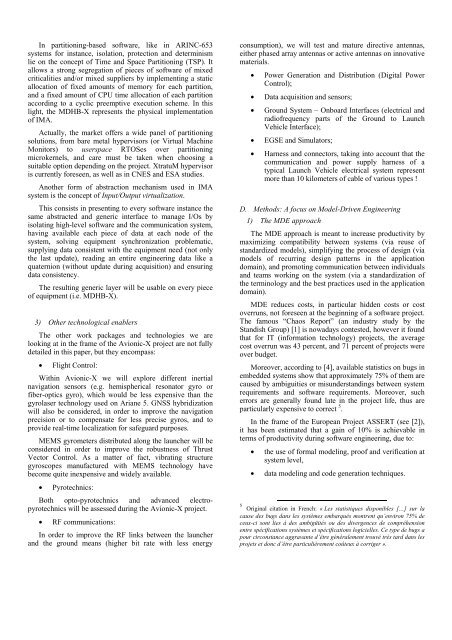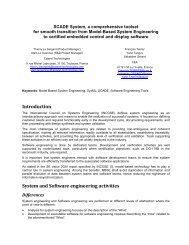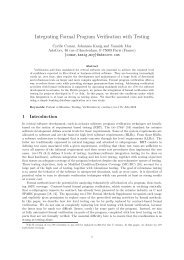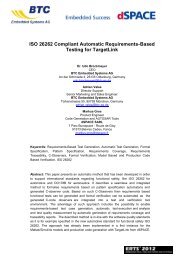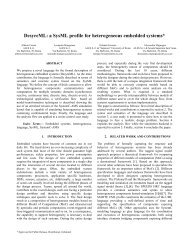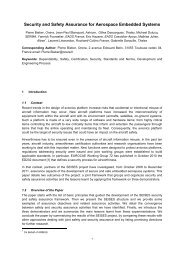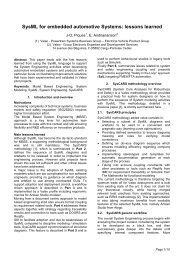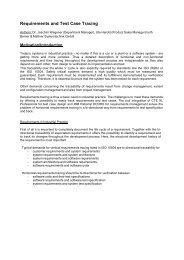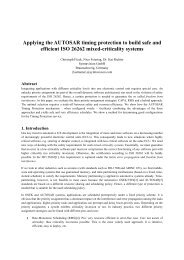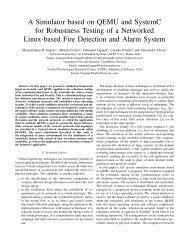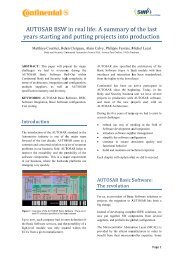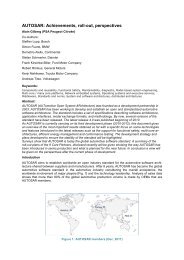Avionic-X: A demonstrator for the Next Generation Launcher Avionics
Avionic-X: A demonstrator for the Next Generation Launcher Avionics
Avionic-X: A demonstrator for the Next Generation Launcher Avionics
Create successful ePaper yourself
Turn your PDF publications into a flip-book with our unique Google optimized e-Paper software.
In partitioning-based software, like in ARINC-653systems <strong>for</strong> instance, isolation, protection and determinismlie on <strong>the</strong> concept of Time and Space Partitioning (TSP). Itallows a strong segregation of pieces of software of mixedcriticalities and/or mixed suppliers by implementing a staticallocation of fixed amounts of memory <strong>for</strong> each partition,and a fixed amount of CPU time allocation of each partitionaccording to a cyclic preemptive execution scheme. In thislight, <strong>the</strong> MDHB-X represents <strong>the</strong> physical implementationof IMA.Actually, <strong>the</strong> market offers a wide panel of partitioningsolutions, from bare metal hypervisors (or Virtual MachineMonitors) to userspace RTOSes over partitioningmicrokernels, and care must be taken when choosing asuitable option depending on <strong>the</strong> project. XtratuM hypervisoris currently <strong>for</strong>eseen, as well as in CNES and ESA studies.Ano<strong>the</strong>r <strong>for</strong>m of abstraction mechanism used in IMAsystem is <strong>the</strong> concept of Input/Output virtualization.This consists in presenting to every software instance <strong>the</strong>same abstracted and generic interface to manage I/Os byisolating high-level software and <strong>the</strong> communication system,having available each piece of data at each node of <strong>the</strong>system, solving equipment synchronization problematic,supplying data consistent with <strong>the</strong> equipment need (not only<strong>the</strong> last update), reading an entire engineering data like aquaternion (without update during acquisition) and ensuringdata consistency.The resulting generic layer will be usable on every pieceof equipment (i.e. MDHB-X).3) O<strong>the</strong>r technological enablersThe o<strong>the</strong>r work packages and technologies we arelooking at in <strong>the</strong> frame of <strong>the</strong> <strong>Avionic</strong>-X project are not fullydetailed in this paper, but <strong>the</strong>y encompass:• Flight Control:Within <strong>Avionic</strong>-X we will explore different inertialnavigation sensors (e.g. hemispherical resonator gyro orfiber-optics gyro), which would be less expensive than <strong>the</strong>gyrolaser technology used on Ariane 5. GNSS hybridizationwill also be considered, in order to improve <strong>the</strong> navigationprecision or to compensate <strong>for</strong> less precise gyros, and toprovide real-time localization <strong>for</strong> safeguard purposes.MEMS gyrometers distributed along <strong>the</strong> launcher will beconsidered in order to improve <strong>the</strong> robustness of ThrustVector Control. As a matter of fact, vibrating structuregyroscopes manufactured with MEMS technology havebecome quite inexpensive and widely available.• Pyrotechnics:Both opto-pyrotechnics and advanced electropyrotechnicswill be assessed during <strong>the</strong> <strong>Avionic</strong>-X project.• RF communications:In order to improve <strong>the</strong> RF links between <strong>the</strong> launcherand <strong>the</strong> ground means (higher bit rate with less energyconsumption), we will test and mature directive antennas,ei<strong>the</strong>r phased array antennas or active antennas on innovativematerials.• Power <strong>Generation</strong> and Distribution (Digital PowerControl);• Data acquisition and sensors;• Ground System – Onboard Interfaces (electrical andradiofrequency parts of <strong>the</strong> Ground to LaunchVehicle Interface);• EGSE and Simulators;• Harness and connectors, taking into account that <strong>the</strong>communication and power supply harness of atypical Launch Vehicle electrical system representmore than 10 kilometers of cable of various types !D. Methods: A focus on Model-Driven Engineering1) The MDE approachThe MDE approach is meant to increase productivity bymaximizing compatibility between systems (via reuse ofstandardized models), simplifying <strong>the</strong> process of design (viamodels of recurring design patterns in <strong>the</strong> applicationdomain), and promoting communication between individualsand teams working on <strong>the</strong> system (via a standardization of<strong>the</strong> terminology and <strong>the</strong> best practices used in <strong>the</strong> applicationdomain).MDE reduces costs, in particular hidden costs or costoverruns, not <strong>for</strong>eseen at <strong>the</strong> beginning of a software project.The famous “Chaos Report” (an industry study by <strong>the</strong>Standish Group) [1] is nowadays contested, however it foundthat <strong>for</strong> IT (in<strong>for</strong>mation technology) projects, <strong>the</strong> averagecost overrun was 43 percent, and 71 percent of projects wereover budget.Moreover, according to [4], available statistics on bugs inembedded systems show that approximately 75% of <strong>the</strong>m arecaused by ambiguities or misunderstandings between systemrequirements and software requirements. Moreover, sucherrors are generally found late in <strong>the</strong> project life, thus areparticularly expensive to correct 5 .In <strong>the</strong> frame of <strong>the</strong> European Project ASSERT (see [2]),it has been estimated that a gain of 10% is achievable interms of productivity during software engineering, due to:• <strong>the</strong> use of <strong>for</strong>mal modeling, proof and verification atsystem level,• data modeling and code generation techniques.5 Original citation in French: « Les statistiques disponibles […] sur lacause des bugs dans les systèmes embarqués montrent qu’environ 75% deceux-ci sont lies à des ambigüités ou des divergences de compréhensionentre spécifications systèmes et spécifications logicielles. Ce type de bugs apour circonstance aggravante d’être généralement trouvé très tard dans lesprojets et donc d’être particulièrement coûteux à corriger ».


